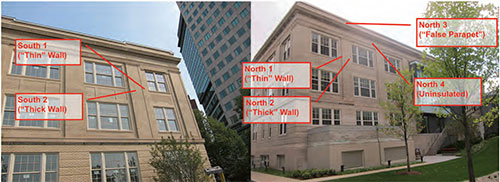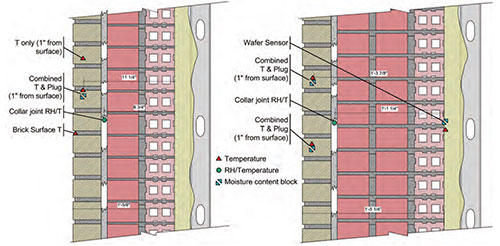A circa 1917 construction mass masonry building located on a Boston-area university campus was retrofitted with interior polyurethane spray foam insulation. Sensors were installed in the retrofitted walls to measure temperature and moisture conditions within the assembly; interior and exterior boundary conditions were also monitored. Hygrothermal simulations were run on the original and retrofitted assemblies using measured site environmental data, both to assess durability risks, and for comparison with the measured data. Durability risks examined included potential for freeze-thaw damage and interstitial condensation. The effect of thermal bridging through structural elements was also examined.
Introduction
Load-bearing mass masonry buildings are a significant portion of the existing building stock in the East Coast and Midwest regions of the United States. Continued use of these buildings (as opposed to demolition) retains the historic character of the building and its associated neighborhood, and utilizes the embodied energy built into these structures. However, in cold climates the need for improved energy performance and greater requirements for occupant comfort are motivations to retrofit insulation in these buildings. The thermal resistance of even thick masonry walls is far below modern code requirements: common moderate density brickwork (80 to 110 lb/ft3 or 1280–1760 kg/m3) can be assumed to provide an R-value from R-0.25 to R-0.33 per inch (k ≈ 0.43 to 0.58 W/[m·K]). Even at a thickness of 12–16 in. (0.3–0.4 m), this only provides insulation levels of R-3 to R-5 (RSI 0.5– 0.9). The use of hollow clay block may add an additional R-1 to R-2 (RSI 0.1 to 0.4).
However, adding insulation to the interior side of walls of such masonry buildings in cold—and particularly cold and wet—climates has the potential to cause or accelerate performance and durability problems. These issues include freeze-thaw damage of the masonry wall, corrosion of embedded metal elements, and potential moisture damage to wood structural members embedded in the masonry. Exterior insulation provides the ideal conditions for building durability; however, many buildings cannot be retrofitted with insulation on the exterior for reasons such as historic preservation, cost, zoning or space restrictions, or aesthetics.
The authors worked with a Boston-area academic institution that owns a large inventory of existing mass masonry buildings. This institution has been moving into capital renovation projects which include the retrofit of interior insulation; to gain a greater understanding of the potential risks, the institution implemented wall monitoring on an initial project. The intent was that the data collected from this site would be used to inform upcoming projects, including the magnitude of potential risks. This work covers the instrumentation, collected data, and analysis of this masonry insulation retrofit project.
Background and Previous Work
An overview of the building physics and durability risks associated with interior insulation of mass masonry buildings is covered by Straube and Schumacher (2007). Interior insulation reduces heat flow through the assembly, thus changing the existing moisture balance of wetting and drying. Given this reduced drying, the retrofit design should reduce wetting in a commensurate manner. The winter temperatures of parts of the inner layers of masonry are also significantly lowered, thereby raising the risk of freeze-thaw damage. The document covers the risks associated with interior-sourced air leakage condensation; this problem is likely when fibrous air permeable (e.g., fiberglass batt) insulation is used with an inadequate interior air barrier. This is a particular problem if the insulation is not applied tightly to the masonry wall, resulting in an air space which allows convective looping. A preferred approach, instead, is to use air impermeable, vapor semi-permeable spray foam, which can achieve airtightness levels required to avoid condensation issues. Wilkinson et al. (2009) installed wall instrumentation in a circa 1950 retrofitted mass masonry three-story building, located in Toronto, Ontario, Canada; their data compared the performance of insulated and non-insulated wall sections.
Wilkinson also provided a review of the current relevant literature, including case studies showing good durability of buildings with interior insulation retrofits, guidance on methods to minimize risks in retrofit design, and specific durability concerns raised during retrofits (freeze-thaw damage of masonry and corrosion of embedded metal components). One conclusion was the fact that although the brick would not meet modern freeze-thaw performance standards, the retrofitted wall had low freeze-thaw deterioration risk (based on both monitored data and simulations). Monitored data suggested that there might be a minor increase in embedded metal corrosion risk, but simulations indicated no added risk; this was ascribed to an artifact of the sensor measurements. Another conclusion was that the embedded wall moisture sensors used were not suitable for detecting moisture contents in the range causing freeze-thaw risk; slow sensor time response also reduced the utility of these sensors.
Mensinga et al. (2010) and Lstiburek (2010) describe masonry material property testing that provides better prediction of freeze-thaw resistance than currently used methods, such as the cold soak/boil ratio or saturation coefficient (ASTM 2012) and rapid freeze thaw (ASTM 2008). The metric used in the recent work is the critical degree of saturation (Fagerlund 1977), or Scrit; masonry can experience unlimited freeze-thaw cycling below this critical moisture content without damage, while above this moisture level, damage will occur quickly. Unlike previous methods, which are simple pass/ fail criteria (suitable versus unsuitable for exposure), this metric results in a limit state design process for assessing the retrofit risk of the assembly. The measured Scrit is used as a risk threshold in hygrothermal simulations; local climate conditions, building exposures, and enclosure design are used as inputs to determine the durability risk associated with the retrofit of interior insulation.
Straube et al. (2012) provides an overview of the topic of interior insulation retrofits of mass masonry buildings. The document includes background on the building physics and potential durability risks, and presents a variety of recommended (and non-recommended) interior retrofit assemblies. This is followed by guidance on problematic details, typically linked with water concentrations on the face of the building, and methods to reduce the moisture loading. The final section provides steps to mitigate risk in these retrofits, including site assessment of the building, various material property tests and computer simulations, site assessment of the driving rain loads, monitoring of prototype insulated assemblies, and recommendations for ongoing post-retrofit maintenance and repair of the building.
Site Description and Monitoring Package
A research project was initiated by a Boston-area academic institution to monitor the in-situ hygrothermal performance of a mass masonry building retrofitted with interior insulation. The test site for this research is the Arthur D. Little Building, which is a three-story (with basement) building (overviews in Figure 1; close up of north and south façades in Figure 2) located in Cambridge, MA (DOE Zone 5A). The building was constructed in 1917, and is on the National Historic Register. The structural elements are site-cast reinforced concrete; the existing walls included (from exterior to interior) face brick, fill brick, hollow clay block, an asphalt-based dampproofing coating, and a directapplied cementitious interior plaster rendering (see Figure 3 for representative wall sections). A major renovation project in 2010–2011 included the installation of insulation on the interior side of the mass masonry assembly. The interior plaster was removed, and open cell polyurethane spray foam (ocSPF) was applied to the interior face of the masonry wall. Insulation was approximately 3 to 3½in. (75 to 90mm)thick, partially encasing the 2 ½ in. (63.5 mm) steel studs, which were spaced approximately 1¾ in. (44 mm) off the masonry wall. This interior wall retrofit assembly addresses air leakage condensation risks; spacing the framing members off the wall reduces the impact of thermal bridging associated with the steel studs. The overall R-value of the retrofit assembly is in the R-10.6 (RSI 1.9) range, using algorithms from Kosny and Christian (1995). The building was occupied in late 2011; the building’s primary function is office space.

Figure 1: Exterior views of the Arthur D. Little Building (left to right): front/south elevation, partial rear/north elevation, and overhead rendering from the south, showing surroundings.

Figure 2: South (front) and north (rear) monitoring locations and wall type nomenclature.
Wall Designations and Nomenclature
The wall instrumentation has been clustered into the following
test walls; they are shown on the building elevation in
Figure 2. Instrumentation was installed on north and south
orientations; project north and south are the rear and front elevations
of the building, respectively; actual orientations are
335° and 155°. Greater emphasis was placed on the northfacing
walls, given the colder conditions, which results in
greater risks of freeze-thaw damage.
- South 1 (“Thin”Wall): The walls that surround the window openings are roughly 12 in. (305 mm) thick and are composed of three layers (interior hollow core clay block, fill brick, and face brick; see Figure 3).
- South 2 (“Thick”Wall): At the main body of the wall or pilasters between windows, the masonry wall is thicker, with two fill brick layers instead of one, resulting in a wall thickness of approximately 17 in. (430 mm).
- North 1 (“Thin” Wall): As per south side, at analogous location.
- North 2 (“Thick” Wall): As per south side, at analogous location.
- North 3 (“False Parapet”): Given the higher rain exposure at the top of the building, additional instrumentation was installed high on the walls, above the third floor’s finish ceiling. Note that this building does not have an actual parapet (roof slab is cast directly on top of the wall); however, this “false parapet” space has high exposure to rain.
- North 4 (Uninsulated): The rear service stairwell has been left uninsulated; therefore, it provides an opportunity to compare the behavior of walls with and without insulation, but with similar exposure. The other remaining walls are insulated. One problem with the installation was that the instrumentation was installed in a location that is sheltered from rain by the roof cornice detail, due to interior details (stairwell landing). In addition, stairwell temperature conditions were not as tightly controlled as interior main space setpoints, including no summertime cooling.

Figure 3: Sensor package for “thin” wall (N1/S1) left; “thick” wall (N2/S2) right.
Sensor Arrangement and Data Acquistion System
A variety of sensors were embedded through the thickness of the test walls; the layout varies depending on wall configuration (Figure 3). The sensors included temperature sensors (±0.2°F [0.1°C] NTC thermistor), relative humidity sensors (thermoset polymer capacitive based sensors; ±3% between 10% and 90% rh), and “moisture content blocks.” The latter sensors are wood-based relative humidity surrogate sensors, described in detail by Ueno and Straube (2008); the moisture content of the wood (eastern white pine) is measured via electrical resistance.
There are two configurations of moisture content blocks: the “plug” sensor (a cylindrical sensor, embedded in a hole drilled into the masonry) and the “wafer” sensor (a flat, thin rectangle of wood which measures conditions at an interface surface, such as between the insulation and the masonry wall). These surrogate sensors were chosen in lieu of relative humidity sensors due to (a) greater longevity in condensing or liquid water wetted environments, (b) greater resolution of bulk water wetting events, and (c) some indication of the accumulation of moisture (or storage) over time. Further information on these monitoring methods is provided in Straube et al. (2002).
Some sensors are duplicates, given the variation that can occur in conditions within a wall assembly. The uninsulated wall was wired with the same scheme as the “thick” wall. . .
Download complete document here.
